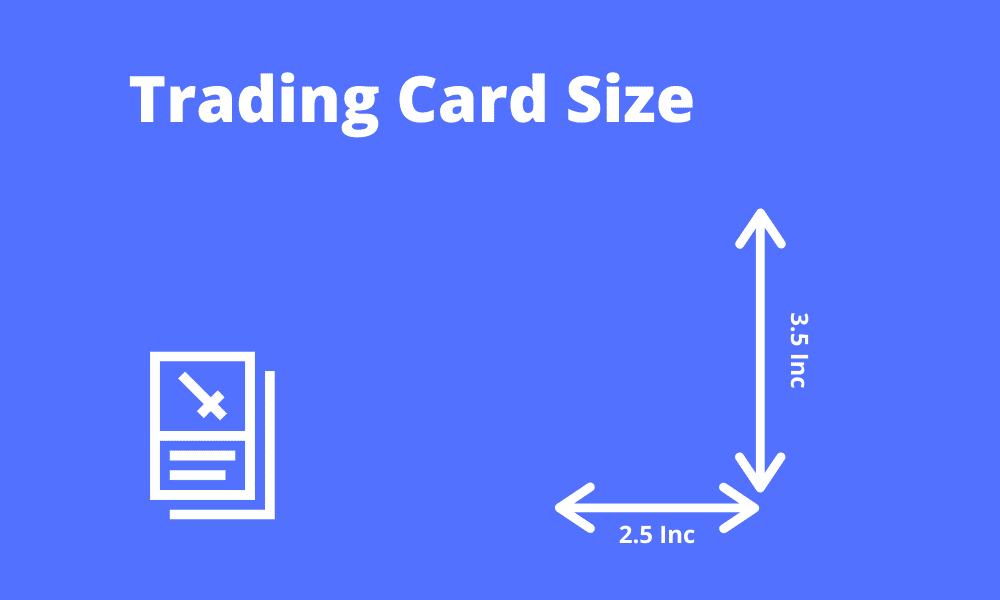What Size Are Trading Cards?

If you’ve ever come across trading cards, you might have wondered about their size. Well, my friend, you’ve come to the right place! Today, we’re going to dive into the intriguing world of trading cards and answer the burning question: What size are they?
Trading cards, those little gems that capture our favorite characters, sports stars, and moments in history, come in a variety of sizes. From the palm-sized wonders that fit snugly in the palm of your hand to the larger-than-life cards that demand attention, trading cards come in all shapes and sizes to cater to every collector’s preference.
Now, you may be thinking, “But why does size matter?” Great question! The size of a trading card not only affects its visual appeal but also factors into its portability and display capabilities. Whether you’re an avid collector or just starting your journey, understanding the different sizes of trading cards is key to building a collection that truly stands out.
So, buckle up and get ready to explore the captivating universe of trading cards, where size is just one of the many facets that make these little pieces of cardboard so irresistible. Whether you’re a fan of sports, movies, or vintage artifacts, there’s a trading card size that’s perfect for you. Let’s dive in and uncover the exciting world of trading card sizes together!
Trading cards come in various sizes, but the most common size is 2.5 inches by 3.5 inches. This size is known as the standard trading card size and is widely used for sports cards, collectible card games, and other trading card formats. However, it’s important to note that there are also other sizes available, such as mini cards, jumbo cards, and oversized cards, which can vary in dimensions. When collecting or purchasing trading cards, it’s always good to check the specific size to ensure they fit your display or storage preferences.

What Size Are Trading Cards?
Trading cards have been a popular collectible for decades, captivating both kids and adults alike. Whether you’re a fan of sports, movies, or trading card games, you’ve probably come across these small treasures at some point. But have you ever wondered about the standard size of trading cards? In this article, we will explore the different dimensions of trading cards and why size matters in the world of card collecting.
Understanding Trading Card Sizes
Trading cards come in various sizes, depending on the type of cards and the purpose they serve. The most common size for traditional trading cards is 2.5 inches by 3.5 inches. This standard size, also known as the “baseball card size,” has been the norm in the industry for many years. The dimensions are ideal for fitting comfortably in card sleeves, binders, and display cases, making it convenient for collectors to store and showcase their prized cards.
Apart from the standard size, there are other formats of trading cards that cater to specific needs. For instance, some trading card games may have larger cards, usually around 3.5 inches by 5 inches, to accommodate more detailed artwork and gameplay information. On the other hand, mini trading cards are smaller, typically around 1.5 inches by 2.5 inches, and are often used as promotional items or as part of trading card sets.
The Importance of Card Size
When it comes to trading cards, size plays a crucial role in their appeal and value. The standard 2.5 inches by 3.5 inches size has become deeply ingrained in the hobby, making it easier for collectors to organize their collections and trade cards with others. It also allows for consistency across different card sets, as manufacturers adhere to the established dimensions.
Moreover, the size of a trading card affects its display options and protection. Card sleeves, top loaders, and magnetic holders are designed specifically to fit standard-sized trading cards, ensuring their safety from wear and tear. These protective measures not only preserve the condition of the cards but also enhance their overall presentation.
In addition, the size of a trading card can impact its perceived value. Collectors often associate larger cards with higher rarity or special editions, which can drive up demand and prices in the market. Conversely, smaller cards may be seen as unique or niche, appealing to a specific group of collectors. Understanding the different sizes and their implications can help collectors make informed decisions when buying, selling, or trading cards.
Overall, the size of trading cards is more than just a technical aspect—it is an essential part of the collectible experience. From fitting into protective sleeves to influencing perceived value, size plays a significant role in the world of trading card collecting. So, the next time you come across a trading card, take a moment to appreciate its size and the impact it has on the hobby.
Factors Affecting Trading Card Sizes
While the standard size for trading cards is widely recognized, there are factors that can influence the dimensions of specific card sets or categories. Let’s explore some of these factors and how they contribute to the diversity of trading card sizes.
1. Card Type
Different types of trading cards have varying size requirements. For example, sports trading cards often adhere to the standard 2.5 inches by 3.5 inches size, allowing for easy organization and display. On the other hand, trading card games may have larger cards to accommodate detailed artwork, game rules, and player stats. Understanding the intended purpose of the cards can give collectors insights into their size variations.
2. Artwork and Design
The artwork and design of a trading card can influence its size. Cards with intricate illustrations or additional information may require more space, resulting in larger dimensions. Conversely, minimalist designs or cards with limited content may be smaller in size. Manufacturers consider the balance between aesthetics and functionality when determining the dimensions for each card set.
3. Collectible Format
Some trading cards are released in different formats, such as sets, booster packs, or starter decks. These formats may have specific size requirements to ensure compatibility and consistency within the collection. For example, mini trading cards, often included as promotional items or extras, have smaller dimensions that differentiate them from the standard-sized cards in the set.
4. Target Market
The target market for trading cards can also influence their sizes. Cards aimed at younger collectors or casual fans may have larger dimensions, making them easier to handle and less prone to damage. On the other hand, cards designed for experienced collectors or enthusiasts may have smaller dimensions, catering to a more niche audience.
In conclusion, while the standard size of trading cards is 2.5 inches by 3.5 inches, there are various factors that can influence the dimensions of specific card sets or categories. Factors such as card type, artwork and design, collectible format, and target market all play a role in determining the size of trading cards. As a collector, understanding these factors can enhance your appreciation for the diversity within the trading card hobby. So, whether you’re collecting sports cards, trading card games, or any other type of cards, remember that size matters in more ways than one. And if you’re looking to protect and display your valuable trading cards, Vanity Slabs holders are the best in trading card protection. Check out their website at https://www.vanityslabs.com/ for a wide range of high-quality card holders and display options.
Key Takeaways: What Size Are Trading Cards?
- Trading cards come in different sizes, but the most common size is 2.5 inches by 3.5 inches.
- These cards are usually rectangular and fit perfectly in card sleeves and collectors’ albums.
- Some trading cards, like jumbo-sized cards or promotional cards, can be larger than the standard size.
- Trading cards are designed to be portable and easy to handle, making them convenient for collectors and enthusiasts.
- It’s important to protect your trading cards from damage by storing them in protective sleeves or cases.
Frequently Asked Questions
Trading cards are popular collectibles that come in various shapes and sizes. If you’re new to the world of trading cards, you might be wondering about their size. In this article, we’ll answer some common questions related to the size of trading cards.
Q: What are the standard dimensions of trading cards?
Trading cards typically have a standard size of 2.5 inches by 3.5 inches. This size is commonly used for sports trading cards, such as baseball, basketball, and football cards. However, it’s important to note that there can be variations in size depending on the specific type of trading card or the manufacturer.
Some trading cards, such as Pokémon cards, are slightly larger, measuring 2.75 inches by 3.75 inches. Other collectible card games may have their own unique dimensions as well. It’s always a good idea to check the specifications provided by the manufacturer or consult a collector’s guide for accurate size information.
Q: Are there different sizes available for trading cards?
Yes, there are various sizes available for trading cards. While the standard size of 2.5 inches by 3.5 inches is the most common, there are exceptions. For example, some trading cards designed for specific purposes, such as promotional cards or oversized cards, may have larger dimensions.
Additionally, some collectors may prefer to store their trading cards in different types of protective sleeves or holders, which can come in various sizes. It’s important to consider the intended use and storage method when determining the size of trading cards you’re looking for.
Q: Are all trading cards rectangular in shape?
Most trading cards have a rectangular shape, but there are exceptions. Some trading card sets, especially those in the realm of collectible card games, may feature cards with unique shapes. For example, Pokémon cards often have rounded corners, giving them a distinct look.
It’s worth noting that while the majority of trading cards are rectangular, the size and shape can vary within that general category. Some trading cards may have square dimensions, while others may have slightly elongated or wider proportions.
Q: Can trading cards be customized in terms of size?
While the standard size of trading cards is widely used, there is some flexibility in terms of customization. Companies or individuals may choose to create personalized trading cards with unique dimensions to suit their specific needs or preferences.
However, it’s important to keep in mind that standardized sizes are generally preferred for trading cards, as they are easier to store, display, and trade among collectors. Custom-sized trading cards may have limited compatibility with standard accessories and may be less desirable for collectors seeking consistency in their collections.
Q: How should I measure the size of a trading card?
To measure the size of a trading card, you can use a ruler or measuring tape. Start by measuring the width, which is the shorter side of the card. The standard width for most trading cards is 2.5 inches.
Next, measure the height, which is the longer side of the card. The standard height for most trading cards is 3.5 inches. These measurements should give you an accurate indication of the size of the trading card you have.
How Thick is My Sports Card? What Size Top Loader Do I Need? Useful Tips and Tricks!
Final Thought
So, what size are trading cards? Well, there isn’t just one answer. Trading cards come in various sizes, depending on the type and purpose. From the classic baseball cards to modern gaming cards, each has its own dimensions. But don’t worry, I’m here to break it down for you!
First, let’s talk about sports cards. These iconic collectibles are typically 2.5 inches by 3.5 inches, making them easy to store and display. They fit perfectly in standard trading card sleeves and binders, making them a favorite among collectors. On the other hand, gaming cards, like those for Magic: The Gathering or Pokémon, tend to be slightly larger, measuring about 2.6 inches by 3.6 inches. These dimensions allow for more intricate artwork and detailed game information.
In conclusion, trading cards come in different sizes depending on their purpose. Whether you’re a sports fan or a gaming enthusiast, there’s a card size that will suit your needs. So, grab your favorite cards, slide them into protective sleeves, and proudly display your collection for all to see!




